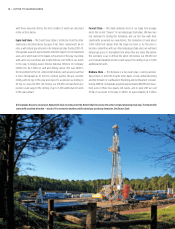Chesapeake Energy 2010 Annual Report Download - page 20
Download and view the complete annual report
Please find page 20 of the 2010 Chesapeake Energy annual report below. You can navigate through the pages in the report by either clicking on the pages listed below, or by using the keyword search tool below to find specific information within the annual report.
Martha Burger
Senior Vice President –
Human and Corporate Resources
What innovations and advancements have led to CHK’s ability to produce liquids from
shales and other tight reservoirs?
During the past five years, Chesapeake and a few other leaders in the independent E&P industry have developed
expertise in exploiting shales and other tight reservoir formations targeting natural gas through the combination of
horizontal drilling and advanced fracture stimulation techniques. This has allowed the commercialization of plays that
were previously uneconomic, most notably in shale formations. Part of our success in producing liquids from tight
reservoirs has come from the company’s ability to extend the technological advances gained in the development of
tight natural gas formations to new formations known to contain substantial liquids. This led to our first liquids-rich
play discovery in the Colony Granite Wash in 2007. As we have increased our focus on liquids-rich plays, we have ben-
efited from a growing understanding and mapping of petrophysical properties in unconventional formations as well
as an enhanced understanding of the geochemical nature of liquids-rich reservoirs. This has allowed Chesapeake to
better identify formations most likely to generate liquids-rich production, including more than a dozen new plays for
the company. We have subsequently improved the success of our liquids-rich plays through the use of optimal well-
bore lateral lengths, better placement of well laterals though advanced wellbore steering techniques and customized
fracture stimulation designs for liquids-rich plays that allow the company to achieve a greater stimulated rock volume
in low permeability reservoirs. Finally, the advancements Chesapeake has made in developing liquids-rich plays have
been made possible through the use of our proprietary Reservoir Technology Center that has become the industry’s most advanced shale core laboratory.
It is often said that the energy industry has an aging work force that is fast approaching
retirement age. How is Chesapeake addressing this?
It is no secret that there is a shortage of experienced professionals in the natural gas and oil industry. The industry down-
turn of the 1980s and 1990s discouraged many from pursuing energy careers. In the following decades, strong compe-
tition from other industries lured away many of the best and brightest science and technology graduates, and today
many experienced professionals who stayed in the industry through the downturn are approaching retirement age.
As a result, one of our industry’s greatest challenges over the past 10 years has been to develop a new generation
of natural gas and oil professionals who have the knowledge and experience required to meet the nation’s growing
energy needs.
In 2000 Chesapeake was one of the first companies to recognize this trend and to understand how recruiting
and training a new generation of energy professionals would impact the company’s future success and its ability to
compete in the industry. At that time, Chesapeake formulated a business strategy to address future staffing needs
and decided to create a world-class college recruiting and intern program to recruit the most promising industry
talent. Today, Chesapeake hosts more than 150 interns every summer in its internship program, many of whom go
on to become full-time Chesapeake employees upon graduation. In addition, we have 350 students who receive
scholarships through Chesapeake programs, and our staff of college recruiters has developed strong relationships with professors, department heads
and career counselors at the more than 31 universities where we actively recruit.
As a result of these efforts, young professionals in a wide range of disciplines, from scientists and engineers to land management and legal
specialists, are being groomed to take over the reins as they learn the business through mentoring, extensive training, development opportunities
and challenging work assignments. They are generously rewarded with excellent compensation and benefits, as well as an industry-leading working
environment that encourages camaraderie and teamwork. The success of Chesapeake’s strategy is apparent: the average age of the company’s
geoscience, land and engineering departments has dropped from 49 in 2000 to 36 today. In addition, the average age of the company’s 4,000
Oklahoma City headquarters employees is 33. Even as some of Chesapeake’s employees retire, the company is well equipped with a seasoned work
force that is prepared to support and lead the way in Chesapeake’s continued growth.
CHESAPEAKE MANAGEMENT
PERSPECTIVES »
Steve Dixon
Executive Vice President –
Operations and Geosciences and
Chief Operating Officer
20 | INVESTOR Q&A
























